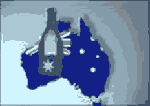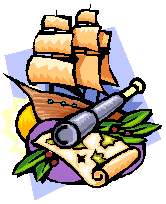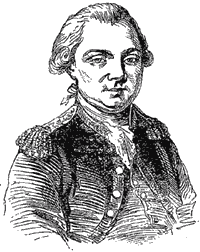
| Les Fêtes |
| All about Paris |
| U3A French |
| The Métro |
| Icons of France |
| 19th Century France |
| Famous French People |
| Dogs in France |
| French Chateaux |
|
Australia could have been French!
|
|
Strange but true!
The "what ifs" of history have meant that Australia could have become a colony of France on two different occasions!
Read on to find out more. Australia could have been French! Louis Aleno de Saint-Allouarn, a French navigator, discovered Australia in 1772. Louis Aleno de Saint Allouarn was a sailor from Brittany. He was a navigator in search of the famed and mysterious "Southern Continent". As captain of the "Gros Ventre" (Big Belly), a boat of some 300 tonnes with a crew of 120 men, he disembarked in Shark Bay in West Australia on the 30th March 1772. He dispatched several crewmen, who, after having explored the surrounding countryside - which was empty of all traces of habitation - proclaimed French authority over this land "Australis Incognita".
According to the habits and customs of his time, he buried, at the foot of a tree, a bottle containing two six franc "écus" (coins) as well as a parchment document stating that he had taken possession of the territory in the name of the King, Louis XV. They did not forget to fire the traditional rounds of ammunition to mark the event. At the same time, Etienne de Rosily-Mesros, plotted the coastline and drew up a map.
In fact, you could say that the Gros Ventre had struck Australia by pure chance. Four years earlier, she had left Mauritius to accompany another ship, the Fortune, seeking the sixth continent, something which had been the dream of all sailors for the previous two centuries. However, in the course of their voyage, a storm had separated the two ships. Saint Allouarn would never again see his home region of Brittany. He died in Mauritius, on the return trip, at the age of 35, exhausted by voyage. He never would be able to give his personal account of his conquest of Australia to the king
We had to wait until 1998 to know the end of this amazing story. For 226 years, the bottle containing the details of his taking possession of Australia lay buried on the Australian coast. It had not been discovered by any researcher. Then on 5th January, 1998, a Frenchman from New Caledonia, Philippe Godard, discovered on the end of Dirk Hartog Island, a French coin, an écu, with the head of Louis XV, and dated 1766.
The following 1st of April, Myra Stanbury, the conservator of the Archaeology Department of the Freemantle Maritime Museum, a port near Perth, brought to light, on the same site, a glass bottle, without any doubt the bottle from the Gros Ventre. Justice was at long last done to Saint Allouarn and his companions. From this time on, the proof was there that during the reign of King Louis XV, a French navigator really had taken possession of half the Australian continent. So, why don't we speak the language of Molière on the Perth side of Australia, like they do in Quebec? Considering that the semi-desert and inhospitable shores of West Australia had little or no value, Paris (or rather Versailles) never followed up Saint Allouarn's initiative. Thus, it was the English who, on 2nd May 1829, took definitive possession of West Australia.
Source: http://service.bretagne.com/ supplements/histoires_ bretagne /1772.htm
|
L'Australie aurait pu être française ! Version française What if the First Fleet had come second? When you eat your BBQ snags on Australia day, spare a thought for Count Jean François de La Perouse. In 1785, La Perouse left France to explore the great southern oceans. And for two and a half years, he'd had them largely to himself. Imagine then, his dismay, as he sailed triumphantly into Botany Bay, only to find a British fleet already at anchor!
Captain Arthur Phillip had beaten La Perouse to this remote bay on the far side of the world by mere days. Seeing the French ships entering the bay, Phillip hastily scrambled ashore to raise the Union Jack. That was January 26th, 1788. Had Captain Phillip arrived on January 27th, perhaps today we'd be throwing snails not snags on the BBQ, resting our plates on knees bruised from too much backyard French cricket!
Thankfully, however, instead of conquering Australia, La Perouse had become its first foreign tourist. Later as he wrote his report, La Perouse must have scratched his head for a way to break the news to his King, Louis XVI. Sadly, we will never know that he said as he and his reports were swallowed by a typhoon in the New Hebrides and never seen again.
Happily, you can still go to the National Library in Canberra and browse drafts of la Perouse's original orders as well as maps and other relics of his voyage, including the journal of Arthur Bowes Smyth. He was Phillip's surgeon and he wrote about the curiously dejected Frenchmen moping about the new colony. (Extract adapted from advert: "See yourself in Canberra - Capital Region". L'Australie aurait pu être française ! Louis Aleno de Saint-Allouarn, navigateur français, aurait tout simplement découvert l'Australie en 1772 ! Le marin breton, à la tête du Gros Ventre, une bateau de 300 tonnes avec un équipage de 120 hommes, débarque le 30 mars 1772 dans la baie des Chiens Marins, devenue aujourd'hui Shark Bay (Australie Occidentale). Il dépêche quelques hommes d'équipages, qui, après avoir exploré les environs - vierges de toutes traces d'habitation, proclament l’autorité française sur cette terra australis incognita. Selon les us et coutumes de l'époque, il enterre, au pied d'un arbre, une bouteille contenant deux écus de six francs, ainsi qu'un parchemin spécifiant la prise de possession du territoire au nom du roi Louis XV. Sans oublier les traditionnels tirs d'artillerie. Parallèlement, Etienne de Rosily-Mesros, fait le relevé des côtes et dresse une carte. En fait, on peut dire que le Gros Ventre accoste en Australie un peu par hasard. Quatre ans plus tôt, il quittait l'île Maurice pour accompagner un autre vaisseau, La Fortune, en quête de ce sixième continent qui meuble, alors, tous les rêves des marins depuis deux siècles. Mais en cours de route, une tempête sépare les deux navires. Saint-Allouarn ne reverra plus jamais la Bretagne. Il meurt à Maurice, à 35 ans, épuisé par le chemin du retour, et ne pourra jamais rendre compte en personne au roi de sa conquête australe. Mais il faut attendre 1998 pour connaître l'épilogue de cette étonnante histoire. Pendant deux cent vingt-six ans, la bouteille de prise de possession enterrée sur la côte australienne a résisté à toutes les recherches. Et voici que le 5 janvier 1998, un Français de Nouvelle-Calédonie, Philippe Godard, découvre à la pointe de l'île de Dirk-Hartog un écu bandeau à l'effigie de Louis XV daté de 1766. Le 1er avril suivant, Myra Stanbury, conservatrice du département d'archéologie du Musée maritime de Fremantle, ville portuaire de Perth, met au jour, sur le même site, une bouteille en verre, sans conteste la bouteille du Gros Ventre. Justice était enfin rendue à Saint-Allouarn et ses compagnons. Désormais la preuve était faite que sous Louis XV un navigateur français avait bien pris possession de la moitié du continent australien. Alors pourquoi ne parle-t-on pas aujourd'hui la langue de Molière du côté de Perth, comme on le fait au Québec ? Considérant ces rivages semi-désertiques et inhospitaliers comme d'aucune valeur, Paris (ou Versailles) n'a jamais donné suite à l'initiative de Saint-Allouarn. Et ce sont les Anglais qui, le 2 mai 1829, prennent définitivement possession de l'Australie Occidentale. |
|
DID YOU KNOW? L'Australie aurait pu etre française deux fois! Australia was nearly claimed by the French twice!
More than 1200mm of rain fell on Brisbane during a week of the el Nino season of 2011.
L'arbre "baobab" peut se defendre contre la secheresse. L'arbre mets en conserve de l'eau dedans son tronc.
En temps aride, les feuilles tombent. A cause de sa forme particulière dans le Queensland on appelle ces arbres "bottle trees"...arbres en forme de bouteille.
The Baobab tree is able to protect itself against drought. It can store watrer in its trunk.
During dry times, it looses its leaves. Because of the strange shape of its trunk, in the form of a bottle, it is called a "bottle tree" in Queensland. |
Penrose








